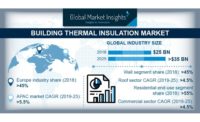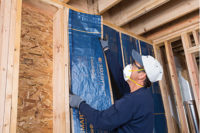The global building thermal insulation market will grow to $35.3 billion by 2027, a CAGR of 4.7 percent from $8 billion in 2022. The use of building thermal insulation has witnessed significant growth because of the increasing requirement for improved heating and cooling comfort and better fire resistance of building thermal insulation materials, such as glass wool, stone wool and plastic foams. The key factors driving the building thermal insulation market are the recovery in new construction of residential and non-residential buildings worldwide.
By material, the building thermal insulation market is classified into glass wool, stone wool, plastic foam and others. Plastic foam is estimated to dominate the market during the forecast period due to its increasing use in external façade insulation, external wall insulation, sandwich panels and cavity wall insulation. The higher compressive strength and energy efficiency of plastic foam, especially EPS foam, is estimated to drive its demand in building thermal insulation.
By application, the building thermal insulation market is segmented into wall insulation, roof insulation and floor insulation. Roof insulation is projected to be the second-largest application of building thermal insulation between 2021 and 2027. The increase in construction of non-residential buildings, such as industrial, commercial, educational and health care buildings, is expected to drive the demand for roof insulation globally.
Building thermal insulation has wide usage in the medical industry. It is imperative for a drug to have a homogenous concentration in a solution; otherwise, it may not be as effective as it was designed to be. Building thermal insulation is added to the drug solution to form a finely dispersed solution. Tablets also have a certain amount of building thermal insulation added to them. By using building thermal insulation, the tablet disintegrates evenly inside the patient's body, thereby working effectively. Homogenous distribution of the pigment or color in the tablet also requires building thermal insulation.
Find out more here.
Research Coverage
This report segments the market for building thermal insulation based on material, application, building type and region, and provides estimations for the overall market size across various regions. A detailed analysis of key industry players has been conducted to provide insights into their business overviews, products & services, and key strategies associated with the market for building thermal insulation.
The key market players profiled in the report include Kingspan Group Plc (U.K.); Knauf Gips KG (Germany); Owens Corning (U.S.); Rockwool International A/S (Denmark); Saint-Gobain SA (France); BASF SE (Germany); Johns Manville Corporation (U.S.); Altana AG (Germany); Dow Inc. (U.S.); GAF Materials Corporation (U.S.); CNBM Group Co., Ltd. (China); Aspen Aerogels, Inc. (U.S.) and others.
Reasons to Buy this Report
This research report is focused on various levels of analysis - industry analysis/trends, market share analysis of top players and company profiles, which together provide an overall view on the competitive landscape; emerging and high-growth segments of the building thermal insulation market; high-growth regions; and market drivers, restraints and opportunities.
The report provides insights on the following pointers:
- Market Penetration: Comprehensive information on building thermal insulation offered by top players in the global market.
- Market Development: Comprehensive information about lucrative emerging markets - the report analyzes the markets for building thermal insulation across regions.
- Market Diversification: Exhaustive information about new products, untapped regions and recent developments in the global building thermal insulation market.
- Competitive Assessment: In-depth assessment of market shares, strategies, products and manufacturing capabilities of leading players in the building thermal insulation market.





Report Abusive Comment